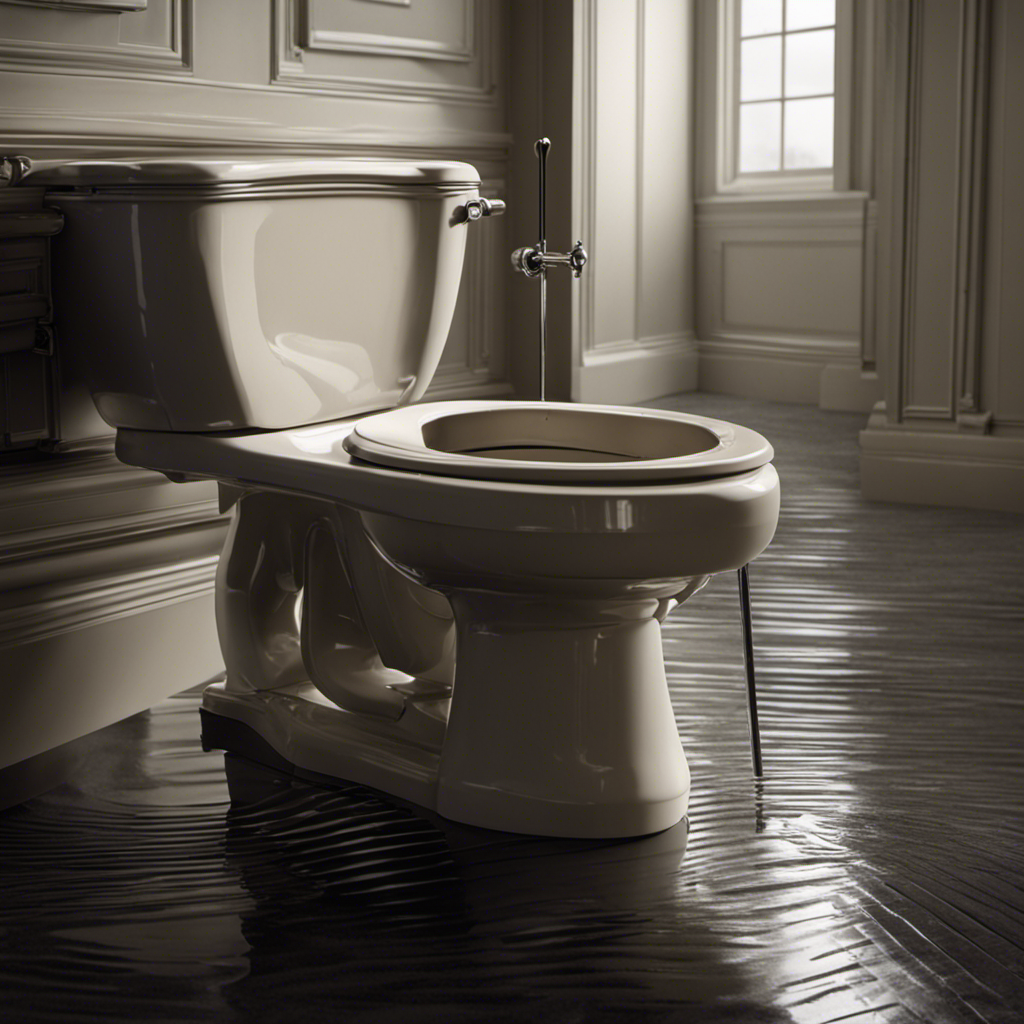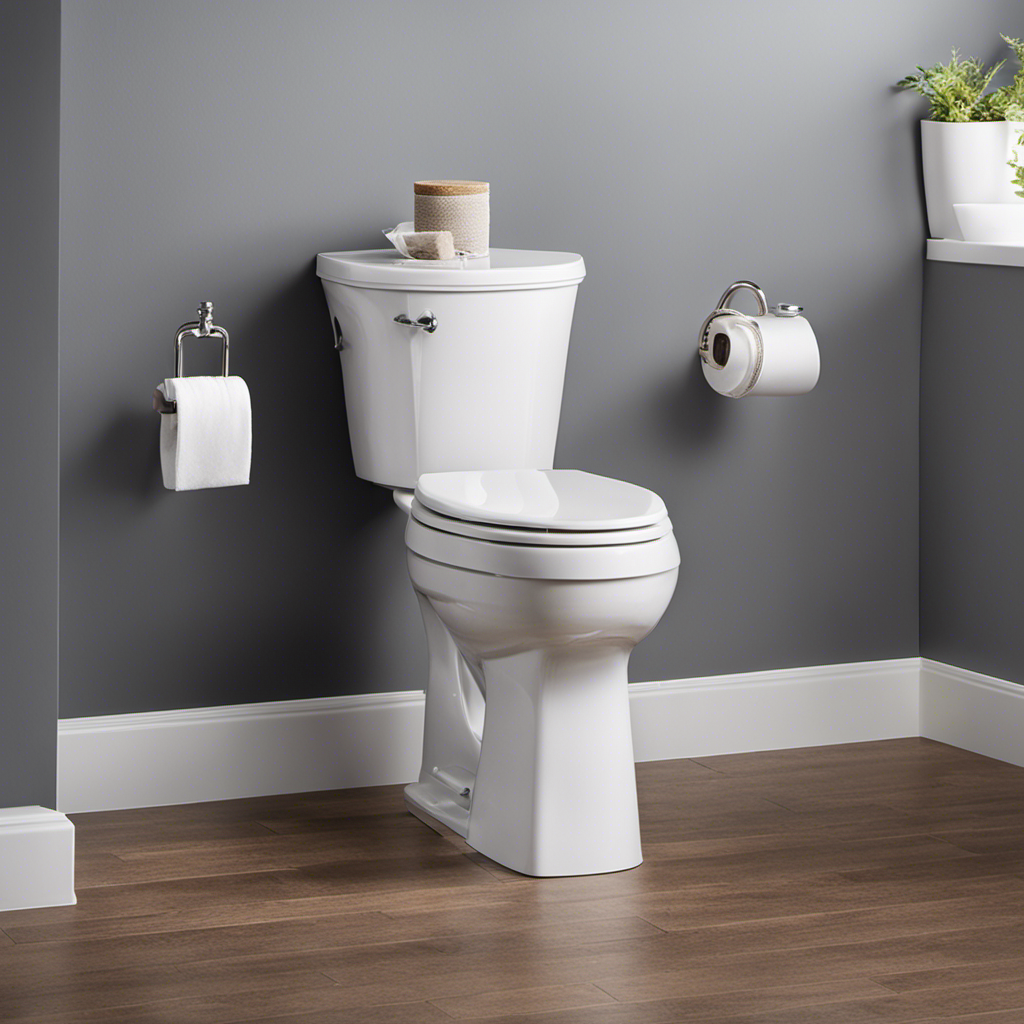Hey there!
Ever dealt with the frustration of a low toilet bowl water level? Trust me, I’ve been there too. But fear not, because I’ve got some tips and tricks to help you out.
In this article, I’ll guide you through the reasons for a low water level, how to assess your toilet’s water supply, and the steps to adjust the fill valve and float ball or cup. We’ll even cover cleaning or replacing the tank flapper.
So, let’s get ready to raise that toilet bowl water level and bid farewell to the annoyance once and for all!
Key Takeaways
- Clogged vent pipe can cause a low water level in the toilet bowl.
- Check the toilet’s water supply, including the water pressure, shut-off valve, and supply line, for any issues.
- Adjust the fill valve to increase the water level by turning the adjustment screw clockwise.
- Maintain an optimal water level in the toilet tank to ensure proper flushing, avoiding both low water levels and high water levels.
Reasons for a Low Toilet Bowl Water Level
One reason you might have a low toilet bowl water level is due to a clogged vent pipe.
The vent pipe is responsible for allowing air to enter the plumbing system, which in turn allows wastewater to flow freely.
When the vent pipe becomes clogged, it restricts the airflow and can cause the water level in the toilet bowl to drop.
To troubleshoot this issue, start by checking the vent pipe on the roof for any obstructions, such as debris or bird nests.
If you find any clogs, carefully remove them to restore proper airflow.
Additionally, ensure that the vent pipe is not blocked by nearby trees or shrubs.
Assessing the Toilet’s Water Supply
Check if there’s enough water coming into your toilet.
When troubleshooting low water supply in the toilet bowl, it is important to assess the toilet’s water pressure. Insufficient water pressure can lead to a low water level in the bowl.
Start by checking the shut-off valve located on the wall behind the toilet. Ensure that it is fully open.
Next, examine the supply line that connects the shut-off valve to the toilet tank. Look for any kinks or blockages that may restrict water flow.
If there are no issues with the shut-off valve or the supply line, the problem may lie within the toilet’s fill valve or flush valve. In this case, it is recommended to seek professional assistance to properly diagnose and resolve the issue.
Adjusting the Fill Valve to Increase Water Level
When it comes to achieving the optimal water level in a toilet bowl, one of the key techniques to consider is adjusting the fill valve. By making adjustments to the fill valve, you can control the amount of water that enters the tank and ultimately determine the water level in the bowl.
There are various fill valve adjustment techniques that can be employed to achieve the desired water level and ensure proper flushing functionality.
Fill Valve Adjustment Techniques
To adjust the fill valve and increase the water level in your toilet bowl, you can easily use a screwdriver to turn the adjustment screw clockwise. This will allow more water to flow into the bowl, increasing the water level. However, it’s important to note that adjusting the fill valve should only be done if you are experiencing low water levels or poor flushing performance.
In order to properly adjust the fill valve, it’s helpful to understand the different parts involved. The fill valve is responsible for regulating the water level in the tank. By turning the adjustment screw, you can increase or decrease the water level as needed.
Here is a table that provides a visual representation of the fill valve adjustment process:
| Step | Action |
|---|---|
| 1 | Locate the fill valve in the toilet tank |
| 2 | Use a screwdriver to turn the adjustment screw clockwise |
| 3 | Test the water level in the toilet bowl |
| 4 | Repeat the process if necessary |
| 5 | Ensure the water level is not too high or too low |
Optimal Water Level
It’s important to maintain an adequate amount of water in the tank of your toilet for optimal flushing performance. Ensuring the water level in your toilet bowl is at the right height is crucial for increasing water efficiency and troubleshooting water level problems.
When the water level is too low, the toilet may not flush properly, leading to multiple flushes and wasting water. On the other hand, if the water level is too high, it can cause constant running and potential overflow issues.
To adjust the water level, locate the fill valve in the toilet tank and adjust the float or float arm. By raising or lowering the float, you can regulate the water level to the recommended height, typically marked on the overflow tube.
Regularly checking and adjusting the water level in your toilet can help conserve water while maintaining optimal flushing performance.
Checking and Adjusting the Float Ball or Cup
You can easily check and adjust the float ball or cup to raise the toilet bowl water level. Float ball maintenance is crucial for ensuring proper water levels in the toilet bowl.
If you notice that the water level is too low, it may be due to a problem with the float ball or cup. Start by removing the tank lid and locating the float ball or cup. The float ball is attached to a metal rod, while the float cup is connected to a plastic arm.
Adjust the float ball or cup by bending the metal rod or adjusting the plastic arm to raise the water level. If the float ball or cup is damaged or worn, it may need to be replaced to resolve any water level issues.
Troubleshooting float cup issues involves checking for any obstructions or debris that may be preventing it from functioning properly.
Regular maintenance of the float ball or cup will help ensure that the toilet bowl water level remains at the desired level.
Cleaning or Replacing the Toilet Tank Flapper
When it comes to maintaining your toilet’s flapper, there are a few key tips to keep in mind.
Firstly, regularly inspect the flapper for any signs of damage or wear. Look out for cracks, leaks, or a flapper that doesn’t seal properly.
If you notice any of these signs, it may be time to upgrade your toilet’s flapper to ensure proper functioning and prevent water waste.
Flapper Maintenance Tips
To prevent water leakage, regularly check and clean the flapper in your toilet bowl. The flapper is a small rubber valve that controls the water flow from the tank to the bowl. Over time, it can become worn or dirty, leading to issues with the water level in the bowl.
Here are some maintenance tips to keep your flapper in good condition:
- Inspect the flapper for any signs of wear or damage.
- Clean the flapper by removing it from the flush valve and rinsing it with water.
- Check the chain connecting the flapper to the flush handle. Make sure it is properly attached and not too loose or tight.
- Adjust the water level in the tank if necessary. This can be done by adjusting the float or fill valve.
- Consider replacing the flapper if it is old or not functioning properly.
Signs of Flapper Damage
Inspect the flapper for any signs of wear or damage so that you can address any potential issues. The flapper is an essential component of your toilet’s flushing mechanism, responsible for regulating the flow of water from the tank into the bowl.
Over time, the flapper can develop problems that affect its performance. One common issue is wear and tear, which can cause the flapper to become warped or cracked. This can lead to water leakage, causing your toilet to constantly run or not flush properly.
Another problem is mineral buildup, which can prevent the flapper from creating a watertight seal. If you notice any of these signs, it’s time for a flapper replacement.
Upgrading Toilet Flapper
If you’re looking to improve your toilet’s flushing performance, consider upgrading the flapper. The flapper is a crucial component of your toilet’s flushing mechanism, and over time it can become worn or damaged, leading to decreased flushing efficiency. Upgrading the flapper can help resolve issues such as weak flushes, incomplete flushes, or constant running water in the toilet bowl.
Here are five reasons why upgrading your toilet flapper is a good idea:
- Improved sealing: A new flapper will provide a tighter seal, preventing water from leaking into the bowl between flushes.
- Better water flow: Upgrading the flapper can enhance the flow of water into the bowl, resulting in a more powerful flush.
- Reduced water waste: A faulty flapper can cause water to continuously run, wasting gallons of water each day. Upgrading the flapper will help conserve water.
- Easier troubleshooting: A new flapper is less likely to cause issues, making it easier to troubleshoot any future problems with your toilet’s flush.
- Enhanced durability: Upgraded flappers are often made from more durable materials, ensuring a longer lifespan and reducing the need for frequent replacements.
Seeking Professional Help for Persistent Low Water Levels
You may want to consider contacting a plumber if you are experiencing persistent low water levels in your toilet bowl. While there are some troubleshooting techniques and alternatives you can try, seeking professional help is often the best solution.
A plumber will have the expertise and knowledge to diagnose the underlying issue and provide the appropriate fix. They can inspect the water supply line, check for any blockages or leaks, and ensure that the toilet tank is functioning properly. Additionally, a plumber can recommend any necessary repairs or replacements to improve the water level and prevent future issues.
Conclusion
In conclusion, raising the toilet bowl water level is a simple task that can be done by anyone. By assessing the water supply, adjusting the fill valve, and checking the float ball or cup, you can easily increase the water level in your toilet bowl.
Additionally, cleaning or replacing the toilet tank flapper can also help maintain a higher water level. If you’re still experiencing persistent low water levels, it may be time to seek professional help.
Remember, a properly functioning toilet with an adequate water level is essential for a clean and efficient bathroom experience.










